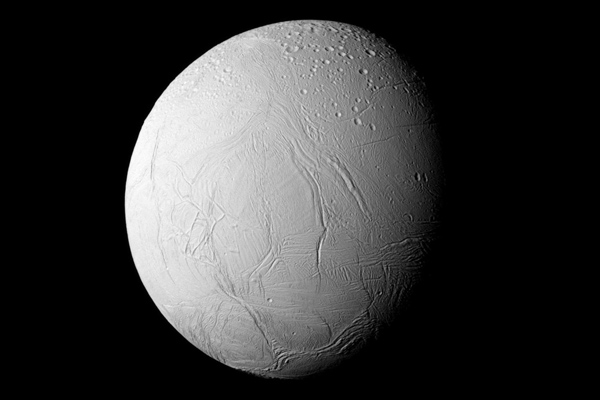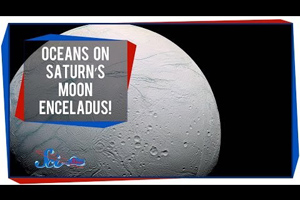Enceladus (Saturn)
Contents
 Enceladus hemisphere in natural colour by Cassini / nasa.gov
Enceladus hemisphere in natural colour by Cassini / nasa.govWhat appears to be a dead frozen world, Enceladus has surprised many as its true nature is revealed. Beneath its icy exterior, there exist the components needed to create and sustain life. Water, heat, energy, organic material, the building blocks of creation.
Discovery
Enceladus was first discovered by Frederick William Herschel in 1789. However, because of both its distance and the glare of Saturn's rings, little else was observed of Enceladus after its discovery until the 1980's. During the Voyager flyby, a clearer understanding of Enceladus' orbit, mass, and density was found along with an unexpected, pleasant surprise. Enceladus was geologically active and had a subsurface ocean.
Position to Saturn
 Enceladus, Saturn's rings and other moon, Titan / nasa.gov
Enceladus, Saturn's rings and other moon, Titan / nasa.govEnceladus orbits 180,000 km (111,847 miles) from Saturn between Mimas and Tethys at 32.9 hours. Enceladus' orbital eccentricity and tidal heating are affected by its sister moon Dione. Tidal heating is the process in which an outside objects gravitational pull, Dione, pulls at the internal structure of another object causing it to expand when it is near.
As they pull away from one another the gravitational pull is weakened and the internal structure contracts. This motion causes friction within the object creating heat. Similar to rubbing your hands together. Dione's resonance is 2:1 which means that for every 1 complete orbit around Saturn, Enceladus has completed 2. Enceladus is also the main source of Saturn's outermost and widest ring, E-ring.
Internal Structure
 A model of the interior of Enceladus / nasa.gov
A model of the interior of Enceladus / nasa.govInternally it is believed that Enceladus' core is made of silicate rock/iron surrounded by a water-ice mantle and an ice crust. Within its South pole region, however, there is a belief that there is a "hot spot" within the core region known as a diapir. This is a spot where the core is molten and has created magma chambers which heat the water-ice mantle creating a subsurface ocean in this region. Evidence of this subsurface ocean has proven that this ocean exists and exploration of it has been proposed for the near future.
Surface/Geography
 Enhanced-color global map of Enceladus / nasa.gov
Enhanced-color global map of Enceladus / nasa.govEnceladus' entire surface is covered in ice giving it a high reflectivity. Because of this, the surface temperatures do not reach over -198°C (-324°F) as the moon does not retain much of the solar heat. There is still some geological activity on the surface. In some areas, the surface is smooth with a lack of impact craters while other areas are covered in them. This shows that there has been recent resurfacing, i.e., geological activity.
Within the South Polar region, plumes of water vapor have been observed. This proved that within this area, there is liquid water beneath the icy surface. This is most likely caused by tidal flexing from its resonance with Dione. With the core being heated, the ice is melted into a liquid ocean, approximately 9.6 km (6 miles) deep. Pressure from heating pushes the water outward to both replenish the surface with fresh "snow" while at the same time replenishing Saturn's E-ring with the icy material.
 South polar region of Enceladus / nasa.gov
South polar region of Enceladus / nasa.govData from the water vapor collected by the Cassini probe show that there is a strong possibility for possible life forming within this subsurface ocean. It has determined that hydrothermal activity is present along with organic material and energy source which are some of the building blocks for the creation of life.
Atmosphere/Climate
 The Geyser Basin of Enceladus / nasa.gov
The Geyser Basin of Enceladus / nasa.govEnceladus is the most reflective body in the solar system due to its surface being completely covered in water-ice. It has been discovered that Enceladus' water-ice is not completely frozen throughout the moon but, in fact, one region is liquid. This liquid is expelled through the ice into the air by geysers and is collected, temporarily, by the moon's weak gravitational pull. So essentially, Enceladus does have an atmosphere but it does not last for very long. What does not get escape into space to replenish the E-ring condenses and falls back to the surface in the form of ice rain.
Exploration
The probes Voyager 1 and 2 were the first two to send back images of this amazing planetary object. These images showed a mostly smooth surface devoid of impact craters except in certain areas. This indicated that Enceladus' surface was still fairly young.
 Artist's concept of Cassini's orbit insertion / nasa.gov
Artist's concept of Cassini's orbit insertion / nasa.govThe Cassini orbiter was directed to Enceladus as a major focus point of observation as it was traveling to orbit Saturn. Its observations prompted further study of Enceladus and prolonged Cassini's mission. It confirmed Enceladus' subsurface ocean and that hydrothermal heating was occurring.
As a result of the data and images collected by Cassini, several future missions have been proposed but no date has been announced as yet. Nasa's JET (Journey To Enceladus and Titan) has been presented as a strong possibility to explore these two potentially habitable moons understand more about them and to search for the existence of life on another world.
See also: All satellites and moons, Saturn's satellites and moons, Saturn, Europa, Objects
Video Gallery

-
 ScienceCasts: Close Encounter with Enceladus
ScienceCasts: Close Encounter with Enceladus
-
 Oceans on Saturn's Moon Enceladus
Oceans on Saturn's Moon Enceladus
-
 Is There Life on Saturn's Moon Enceladus?
Is There Life on Saturn's Moon Enceladus?
-
 Animation: Flight over Enceladus
Animation: Flight over Enceladus